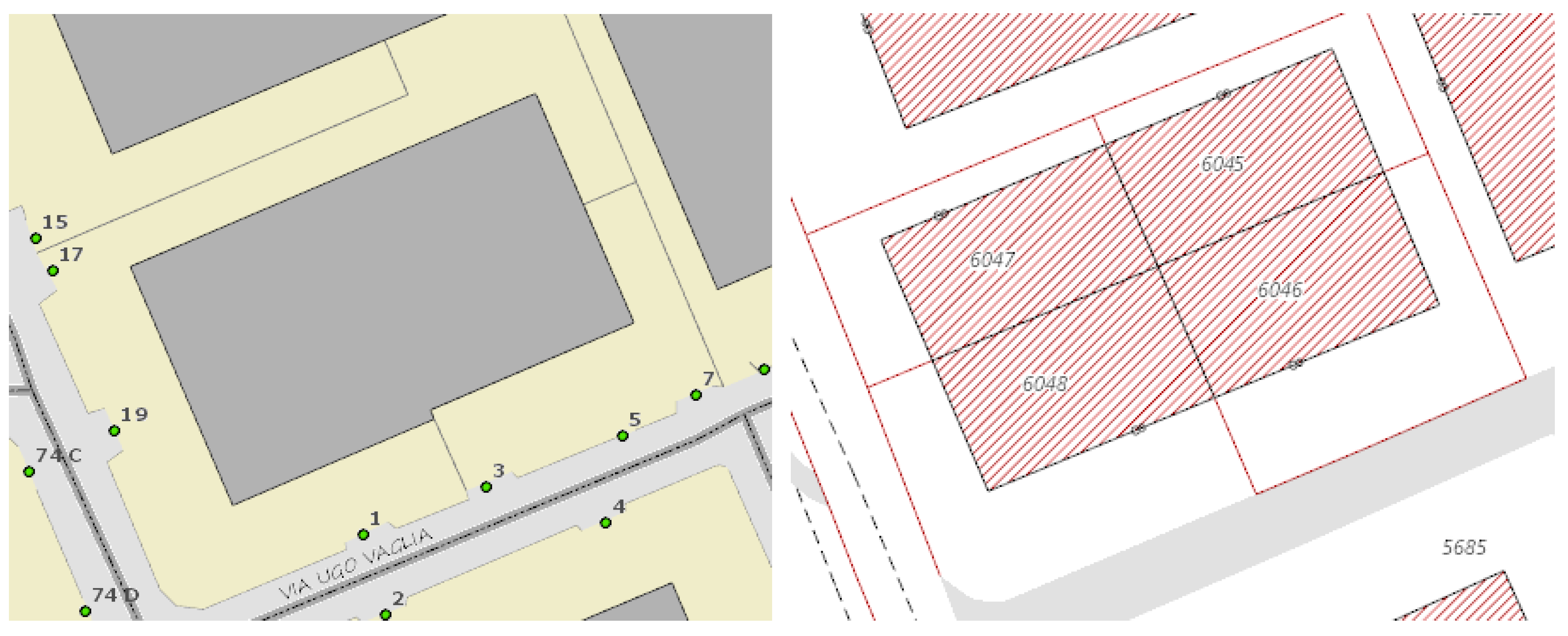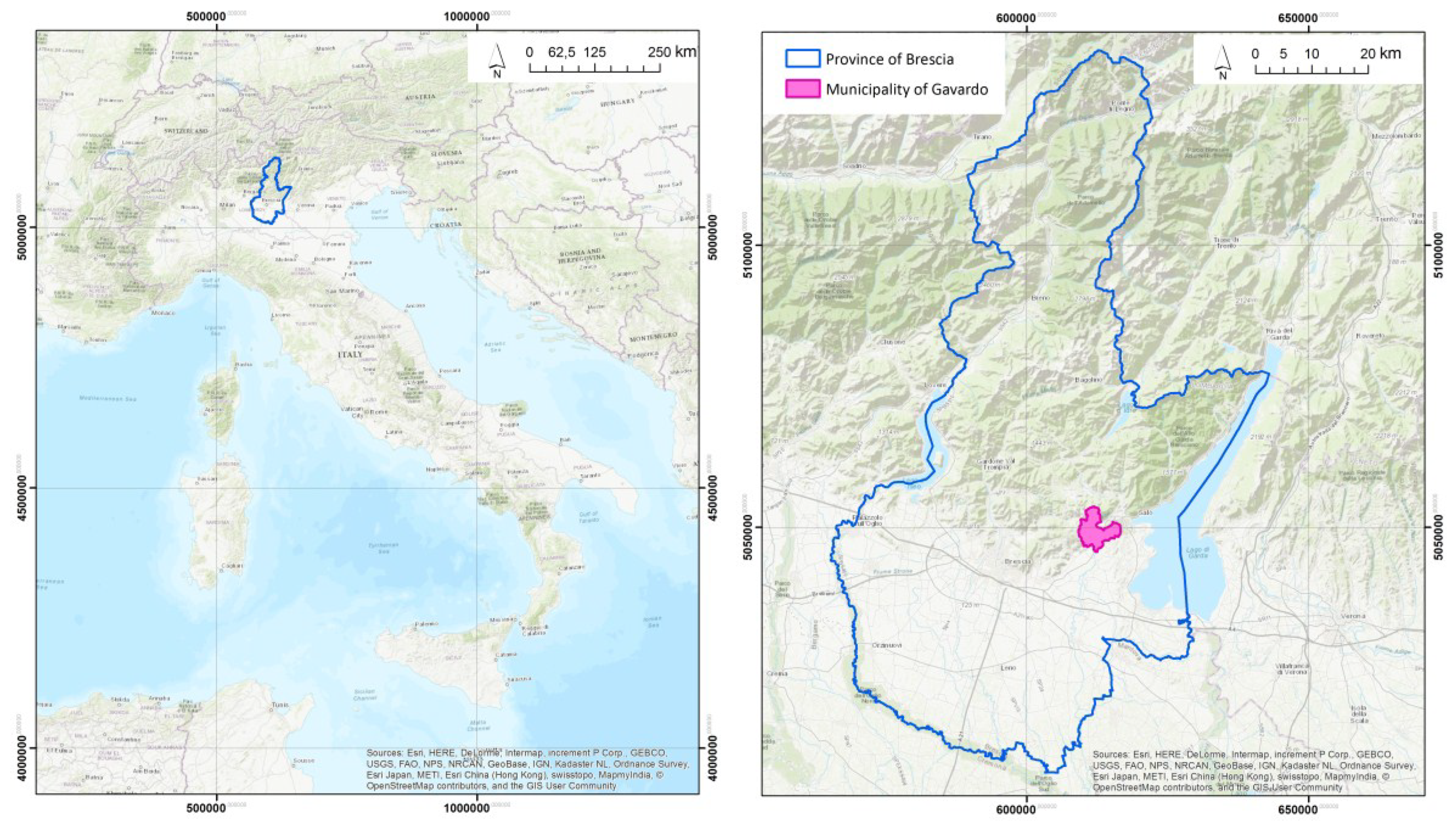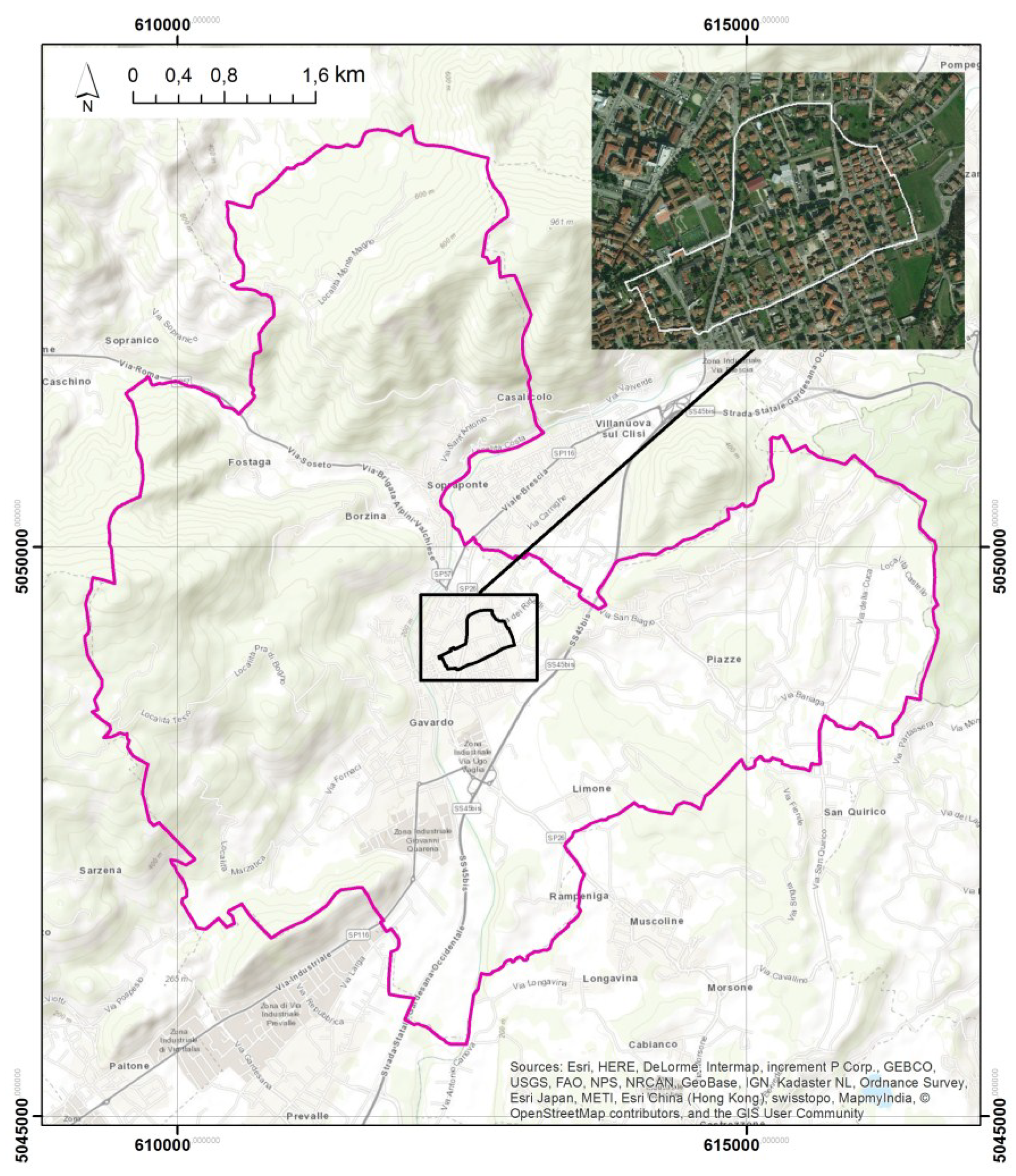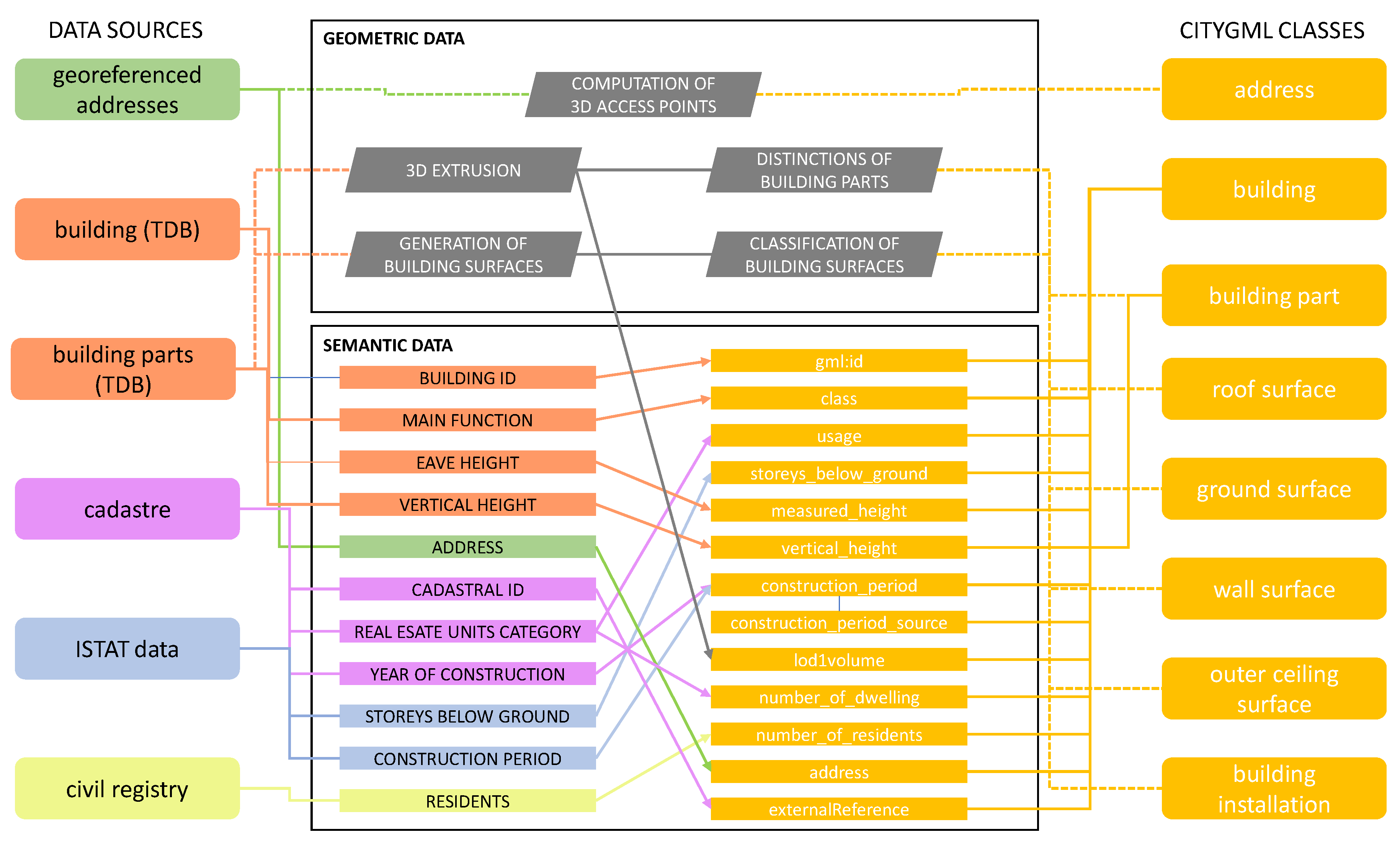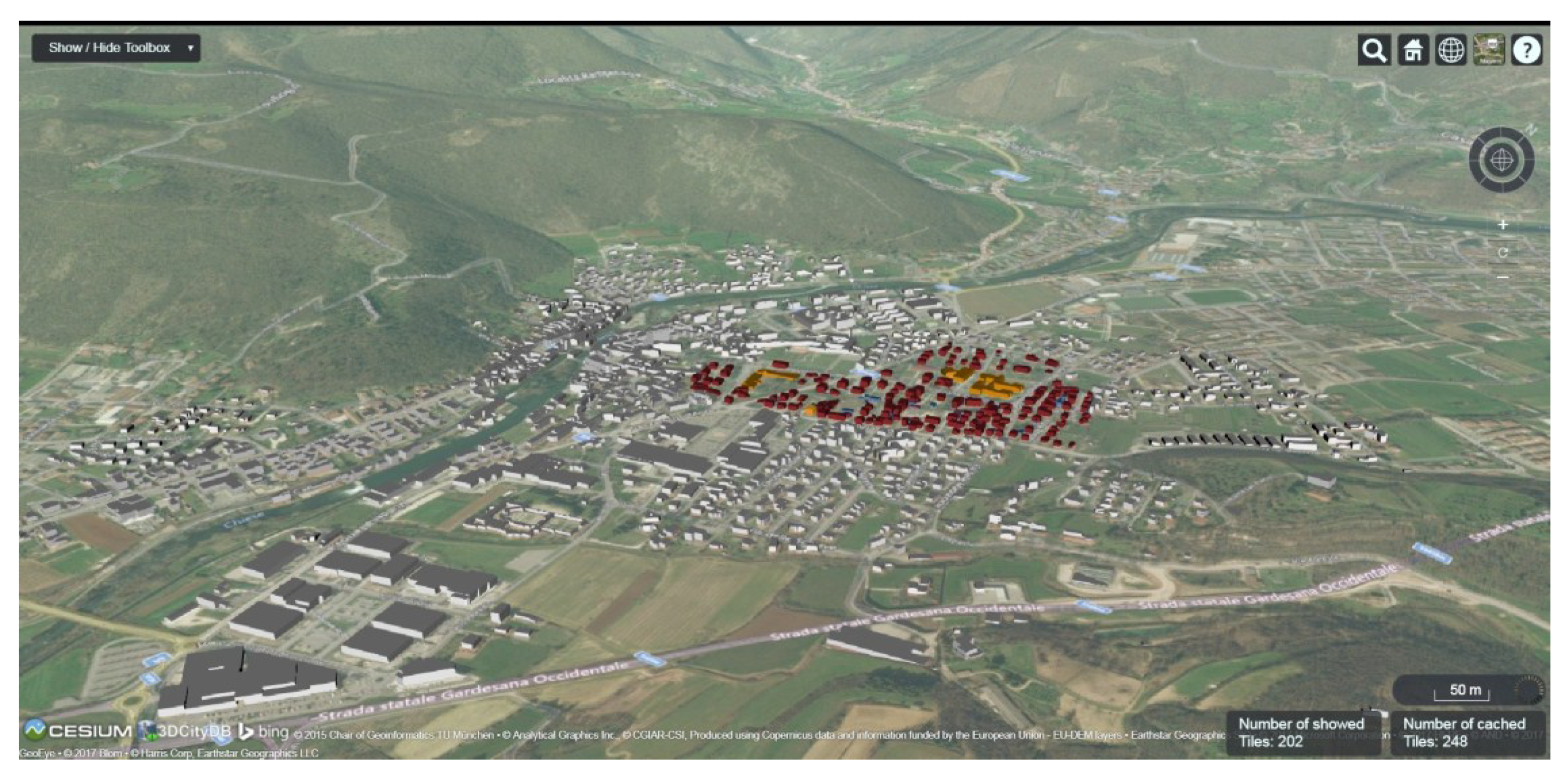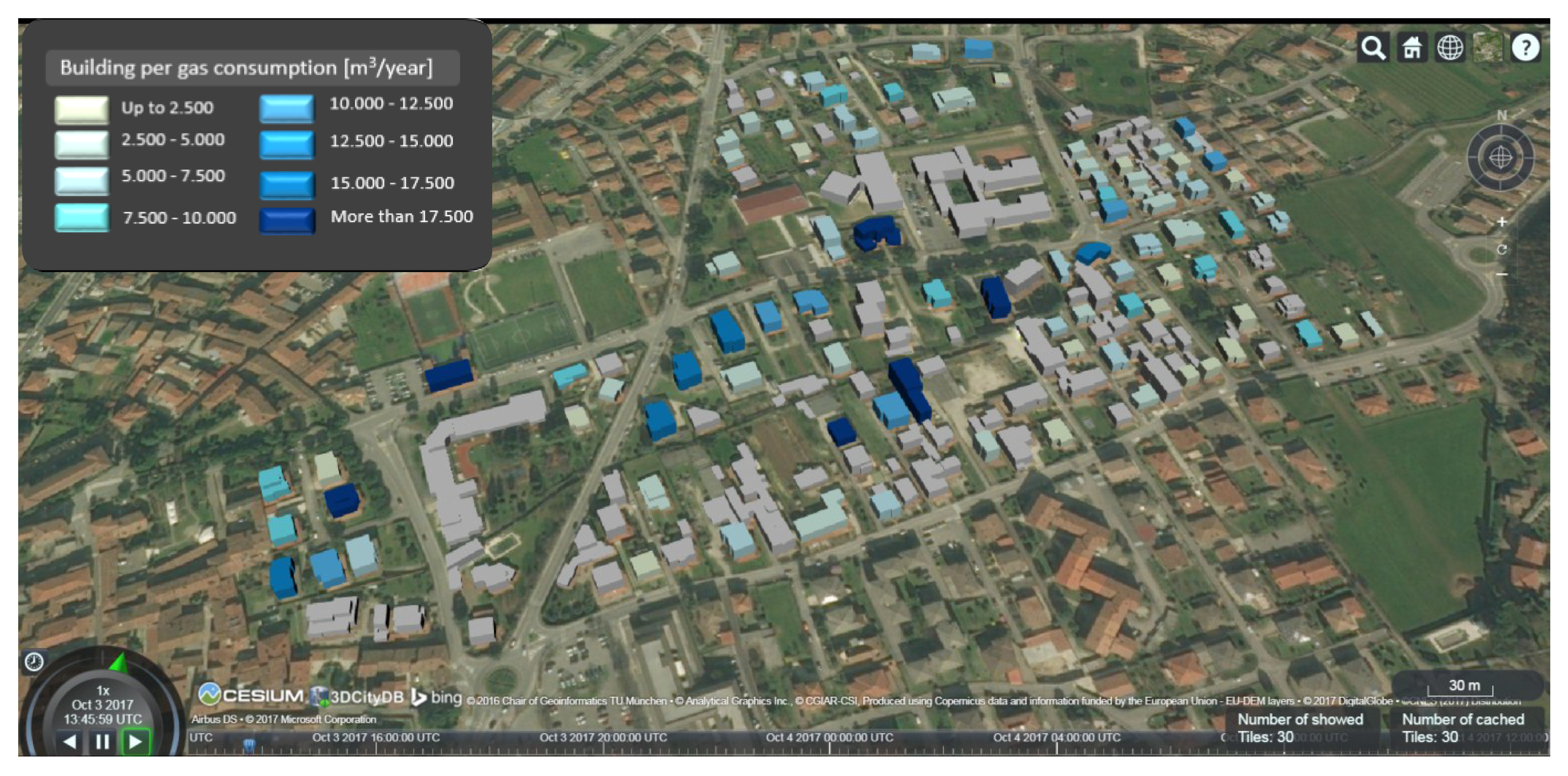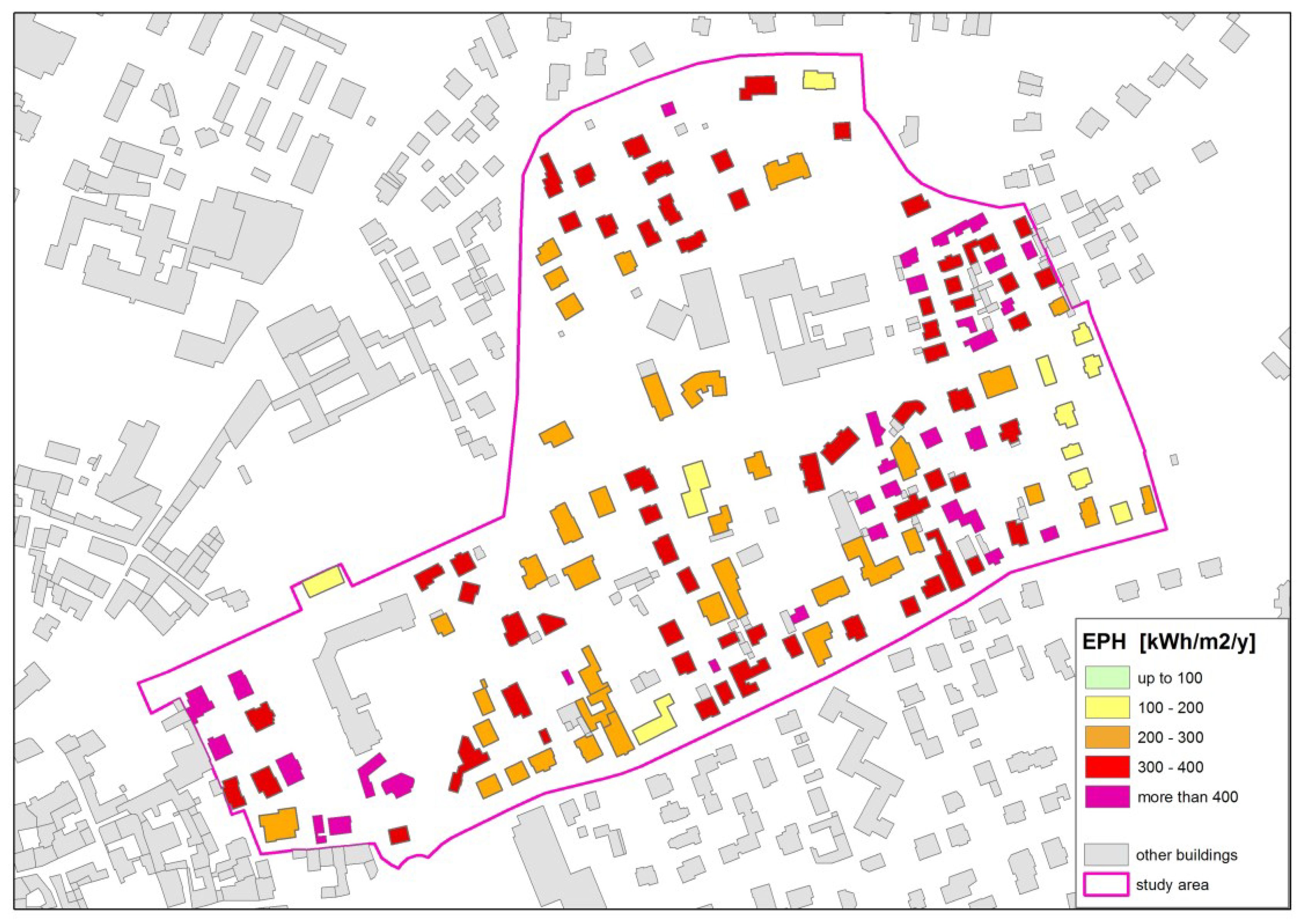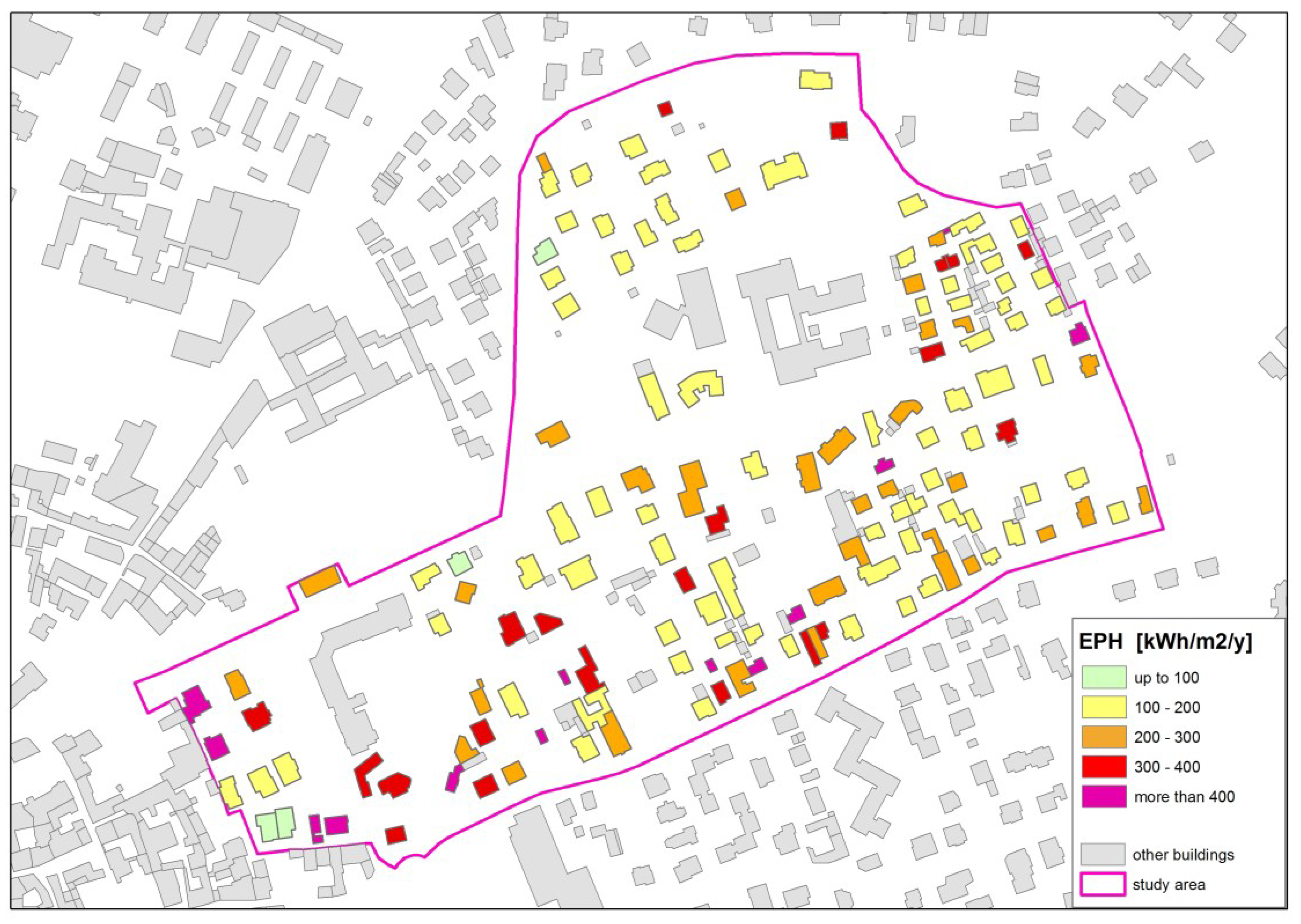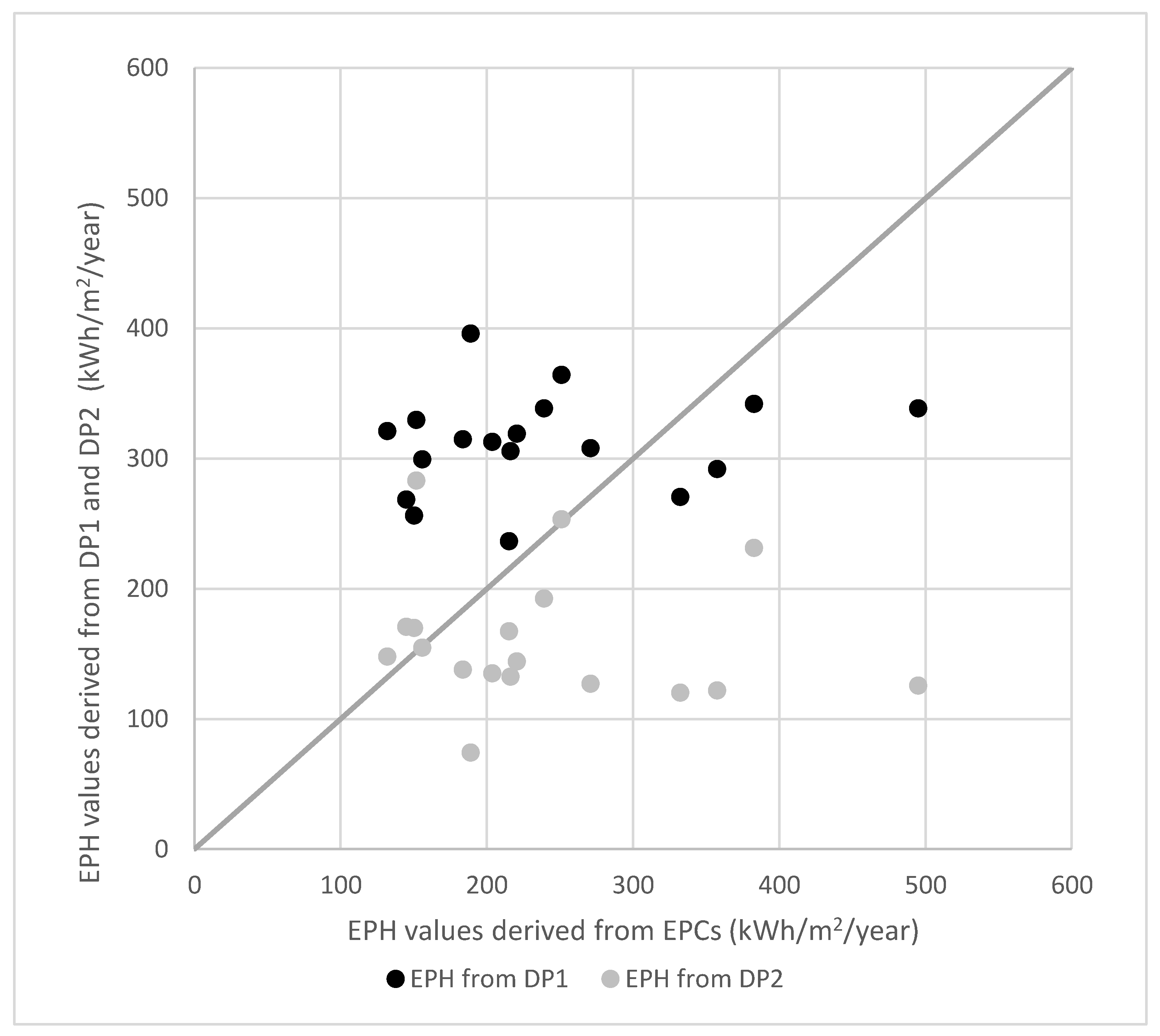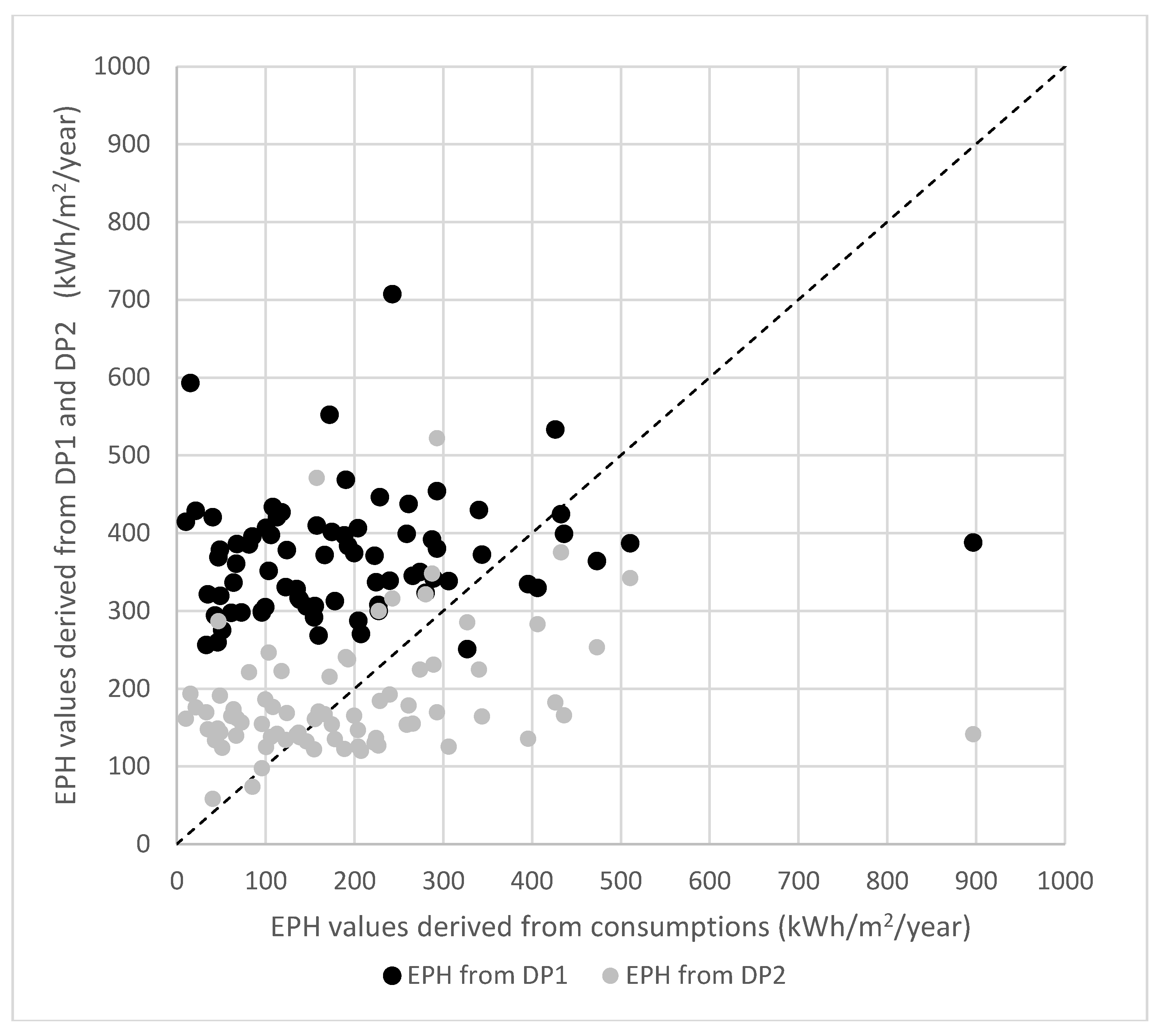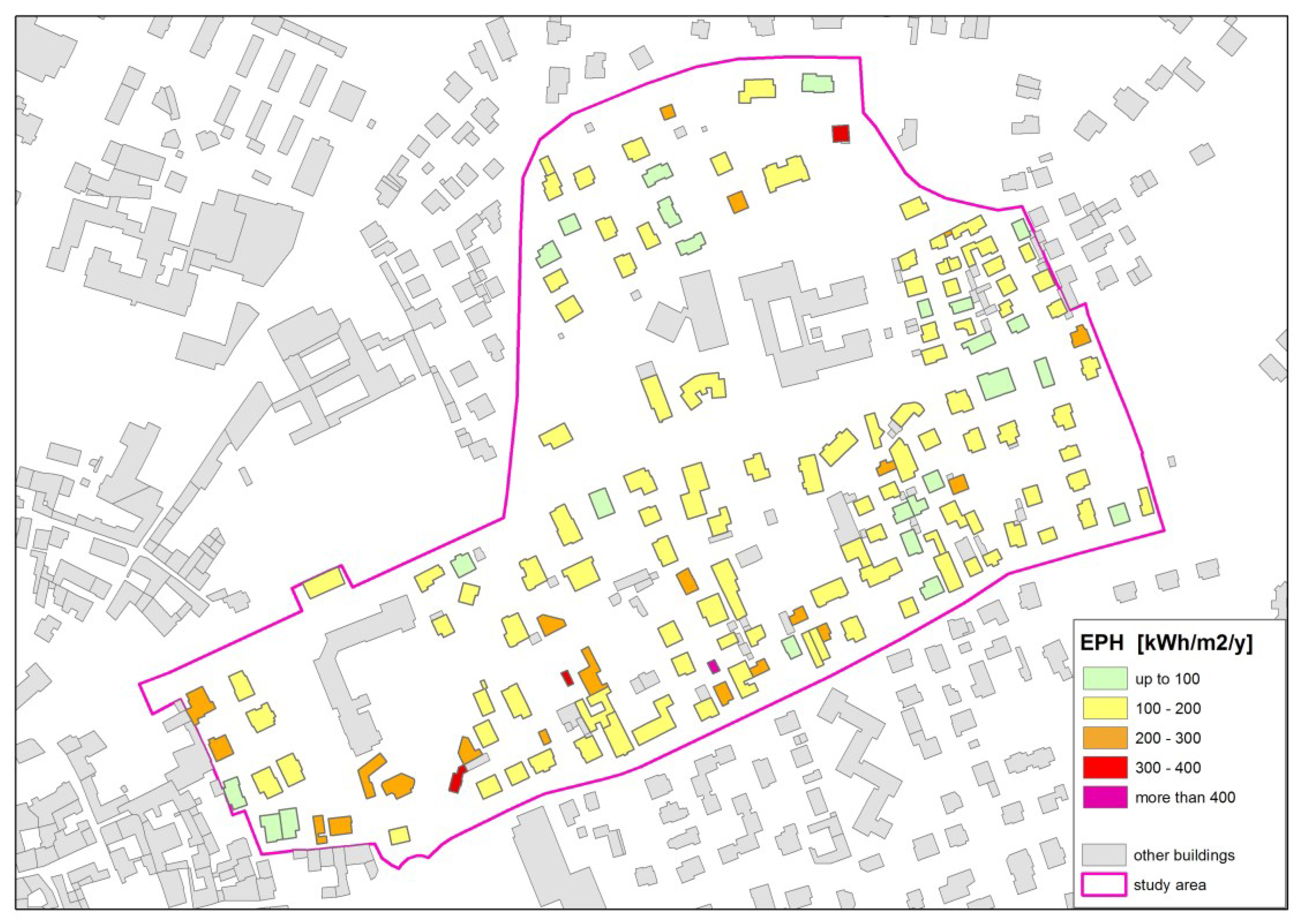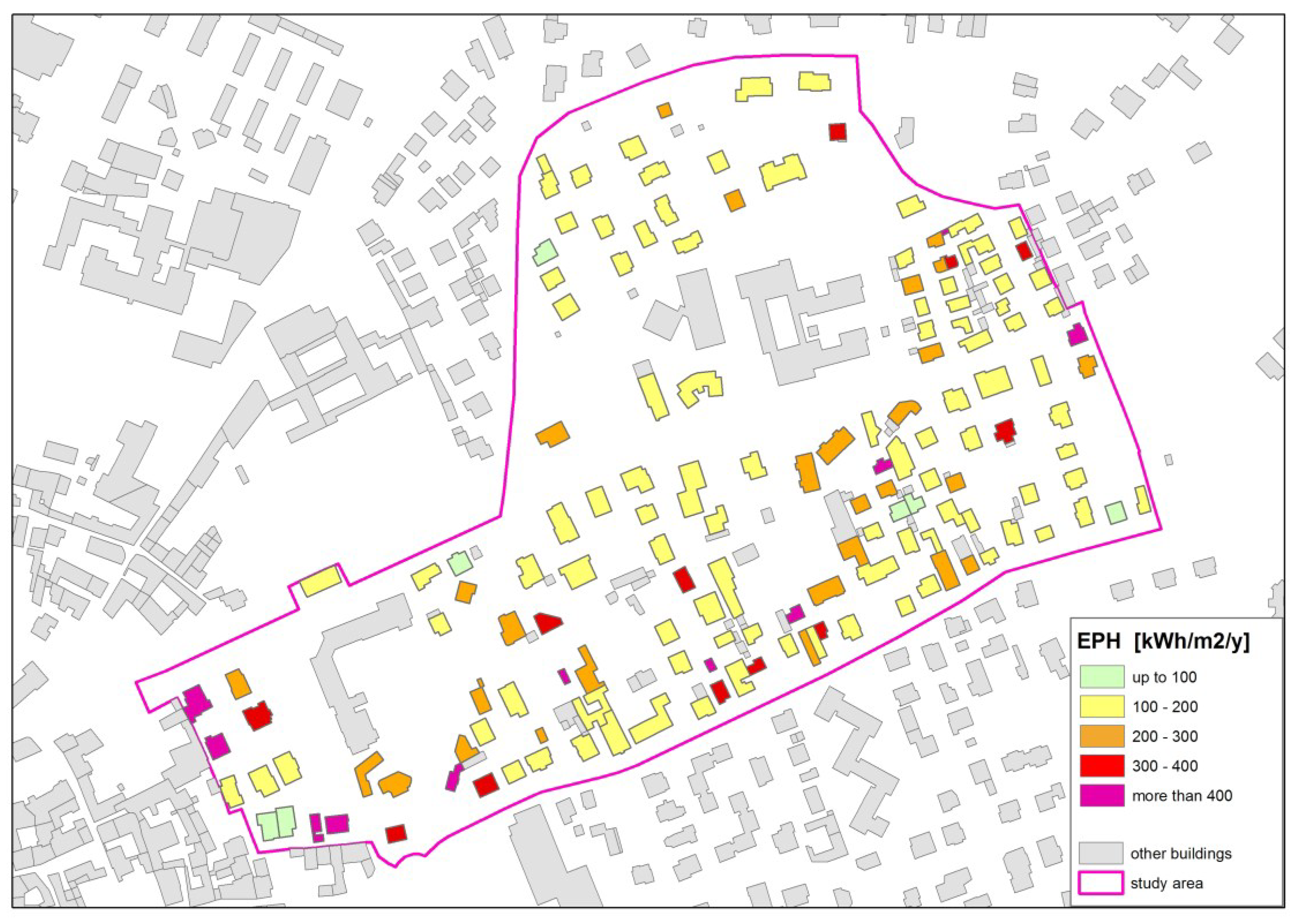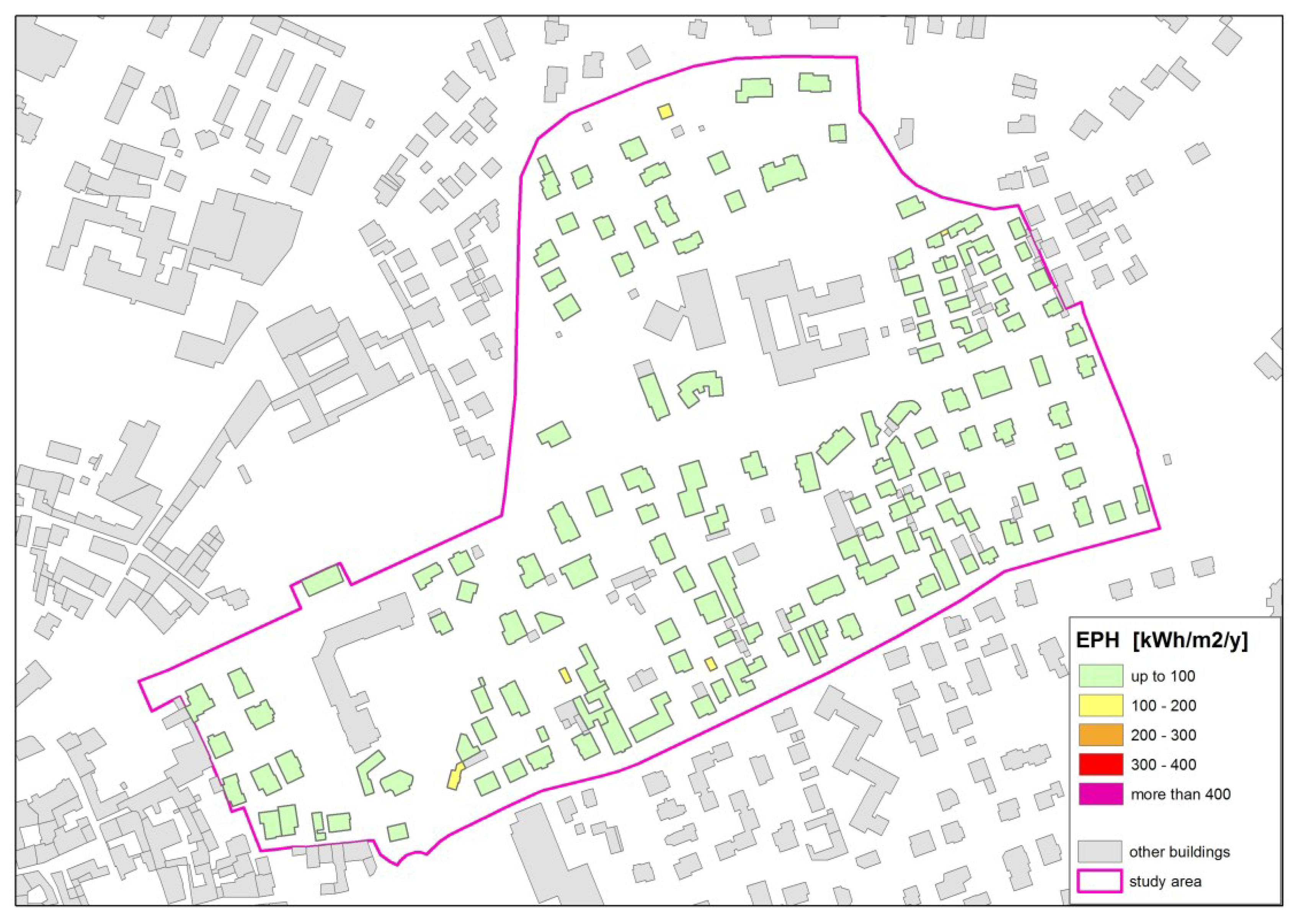1. Introduction
The increased attention paid to the anthropogenic impacts on natural environment has raised awareness on the themes of efficiency, sustainability, and resilience of urban settlements. Contemporary buildings are expected to be very performant from many points of view, ensuring a better quality and a lower carbon footprint of the built environment [
1], a higher protection and resilience from catastrophic events [
2], and a smarter management of assets [
3]. If, on one side, nowadays, it is easy to obtain complete information on new or recent buildings, on the other hand it may not be so easy to retrieve the same quality and quantity of data regarding older, existing buildings. However, the current building stock accounts for the largest part of European cities and entire portions of settlements require a systemic transformation and renovation strategies in order to meet higher sustainability and efficiency requirements. Conversely, the city-wide availability of proper informative tools on urban objects (e.g., buildings, bridges, etc.) to guide such strategies is not always ensured.
The quality and completeness of building information in Italy is characterized by several criticalities: building data are often incomplete and out of date; contents are often replicated in different databases but information may differ due to the different rate they are updated; and, data are not correlated as neither semantic nor spatial references are shared among existing archives [
4]. In short, building information is spread among heterogeneous sectorial databases, each one created for a specific purpose and following an application-oriented approach in data modelling, organization, and management. Consequently, data collection and harmonisation tasks still represent a barrier for the adoption of proper tools supporting policy makers in the definition of urban development and renovation strategies [
5].
The need for organized and usable information on buildings is an issue that has been addressed for some decades by several European countries. In the Netherlands, for example, the creation of an integrated set of key public registers started at the beginning of ‘90s [
6,
7]. Such registers, which are considered to be of primary importance for the public sector, include both geographic data (cadastre, small and large-scale topographic base maps, addresses, buildings, subsoil utility networks) and non-geographic data (residents, companies, vehicles, etc.). The scope of this harmonization process was to improve the management efficiency, the update frequency and the usability of public archives. Consequently, a better reliability of the public informative heritage was achieved, so that this became a real service provided by the cadastre to local businesses [
8]. This also eased the creation of a National Spatial Data Infrastructure (NSDI), enabling in recent years the creation of three-dimensional (3D) city models nationwide [
9]. In Germany, at the beginning of the 2000s, cadastre and topographic information were recognised as the most important base information for GIS. Increasing demands from the market (real estate agencies, banks, insurance companies, etc.) encouraged public authorities to set up an integrated data model for cadastre and topographic database: the contents of the two archives were defined in order to avoid redundancies and duplicated data acquisition, and to enable data interchange [
10]. The availability of harmonised building data also facilitated the creation of 3D city models. In the UK, the national mapping agency (Ordnance Survey) is in charge of the continuous update and maintenance of core geographic information (GI), which may be used by public bodies and private companies as reliable and certified data. Among others, it also includes building-related information. Ordnance Survey is also partner in a pilot project coordinated by the Open Geospatial Consortium (OGC) and
buildingSMART International, focusing on the integration of 3D city models and building models. The mapping agency is also involved in the Digital Built Britain, a government initiative aimed to solicit the digitalisation process within the construction sector [
11,
12]. In Spain, the national cadastre aimed to go beyond its purely fiscal purpose and moved to the 3D mapping of buildings, which includes the modelling of building interiors and distinguishes floors and building units [
13,
14].
The lesson learnt by these experiences may be summarised, as follows:
GI plays a significant role in the modelling of building data, especially when considering that built assets are influenced by the context in which they are located (e.g., the definition of cadastral revenue is influenced by the central or peripheral location within a city) and, in turn, they may influence that context (e.g., construction of a new building shading other buildings and increasing the heating energy demand during the winter season);
the existence of harmonized archives is the key for the provision of complete information on buildings, integrating structural and constructive details (e.g., number of floors and dwellings, physical properties of the construction materials), and socio-economics data (e.g., number of residents, presence of companies and elderly people, etc.); and,
shared and federated data management mechanisms may improve the efficiency in public data handling, avoiding redundancies and incoherencies, and improving the rate of data updating.
The objective of the research presented in this article was to create an integrated Building Information System (BIS) starting from the available information on buildings, which is supposed to enable archive interoperability and provide a complete picture of the building stock within a city. The aim is to demonstrate how such efficiency plans and strategies may be implemented at the district and city scale.
To this purpose, a review of the available building data sets in public archives was made, highlighting their pros and cons and identifying a feasible way to link them (
Section 2.1). Further on, a case study area in Italy was selected, where significant harmonisation work was carried out in order to create the BIS and to bridge the gap between expected and actual data quality. Integrated data were then combined and modelled according to the international standard CityGML (
Section 2.2). In addition to the “base” data model, building data were also structured following the Energy Application Domain Extension (ADE), which extends the base model and provides a common reference for building energy simulation. Finally, a practical case study concerning the estimation of the primary energy demand for winter heating at district scale was accomplished (
Section 2.3): the estimated values were then compared with energy performance certificates (EPC) and measured consumption values, allowing for evaluating the accuracy of energy analysis carried out on a set of 154 residential buildings (
Section 3). It has to be highlighted that the point of view assumed in this research is the one of a public body: all public authorities in Italy have indeed a privileged access to building data and can use them for public, collective purposes.
This article is mainly derived from and it further extends the Ph.D. dissertation of one of the authors [
15], which deals with building data integration. However, this article intentionally focuses on the practical use cases related to building and energy modelling, as well as building analyses at district scale, in order to demonstrate how the effort required to foster data interoperability may lead to an effective usability of public data in urban analyses and applications. A comprehensive description concerning all open issues that are related to public building data or about the practical operations to enforce data interoperability is however beyond of the scope of this article and can be found in the abovementioned document.
3. Results and Discussion
3.1. Parameters and Assumptions for the Energy Demand Calculation
As the accuracy of an energy demand assessment is strictly related to the quality of input data, information, and assumptions used for this work are discussed in the following paragraphs.
3.1.1. Building Construction Period
The knowledge of the building construction period is fundamental to take into consideration the performance of buildings materials and components (e.g., thermal transmittance, heating plant efficiency, etc.). In scenario DP1, the construction period of buildings was derived from historical land use maps and this information was associated to each building through overlay operations. In this way, an approximate construction period was assigned to each building. In scenario DP2, different data sources were used to derive the correct construction period of each building: namely ISTAT microdata, cadastral data, and Energy Performance Certificates (EPCs). When all these data are available, misalignment may appear between the different data sources. When this happened, the cadastral map was chosen as prevalent data source, as cadastral data are submitted to the national registry by professionals in the case of new constructions or renovation of existing buildings. Indeed, the professional in charge of the building construction is also directly responsible for updating the cadastral map. More critical was the level of accuracy of data included in the other two data sources. On one hand, in ISTAT microdata the construction period may be simply determined through a visual inspection made by non-technical surveyors without the need to collect proper documentation or interviews from the owners. On the other hand, a detailed survey is not mandatory to collect data for computing EPCs, and the building construction period may be roughly estimated. For these reasons, when multiple data sources were available, a hierarchical selection criterion was adopted by preferring cadastral data, opting for ISTAT microdata as the second option, and for EPCs as the third source of information.
3.1.2. Number of Floors
The number of floors is required to estimate the heated floor surface of each building and the losses of the heating distribution system. In scenario DP1, the number of floors was derived by assuming a constant storey height of 3 m. As a result, the calculated number of floors might differ from the actual number. In scenario DP2, this information was derived from ISTAT census data, where the number of floors is reported, as surveyed by census operator, or from cadastral data, by analysing the position of REUs on different floors. Even in this case, the information obtained from both sources may be misaligned: ISTAT data may not include attic floors, while cadastral data may not be properly updated. For these reasons, the number of floors attributed to each building was derived first from ISTAT data, and then, in the case of missing information, from cadastral data.
3.1.3. Performance of Thermal Plants
According to [
32], the efficiency of thermal plants was calculated by using a different approach in the case of buildings having centralized and non-centralized thermal plants. Moreover, the energy dispersion due to the distribution system was differently estimated for buildings having more than three floors, while considering a lower rate of efficiency. In scenario DP1, since there is no information that is useful to distinguish between centralized and autonomous heating plants, mean performance values were considered on the basis of the building construction period. A different dispersion degree was considered for buildings having more than three floors above the ground. In scenario DP2, it was possible to identify centralized and non-centralized plants through the comparison between the number of dwellings and the number of utility connections of each building. In this case, distinct performance values were assigned to central and autonomous plants, while always considering different dispersion degrees for buildings having more than three floors above the ground. Performance values of thermal plants were finally calculated by applying generation, distribution, and emission efficiency coefficients proposed by TABULA on the basis of the building construction period.
3.1.4. Thermal and Solar Transmittance
For opaque and glazed surfaces of the building thermal envelope, the respective U (thermal transmittance) and g (solar transmittance) values were taken from those proposed by the TABULA project on the basis of the building construction period. Please note that thermal bridges were considered as an incremental fraction of the thermal transmission losses.
3.1.5. Energy Performance Certificates and Energy Consumption Data
The EPCs and the actual energy consumption values were used to validate, as far as possible, the energy demand estimation. Energy consumption data are reported for every Point-of-Delivery (POD) registered in energy providers’ databases. In order to relate utility connections and buildings, the information that is associated to each POD was aggregated according to the address. As previously mentioned, addresses in these data sets are not structured and they are sometimes incomplete (e.g., the house number is missing). Thus, it was not always possible to associate consumption data to the correct building. As a result, gas consumption data were available only for 77 of the 154 buildings in the study area. Domestic hot water (DHW) and cooking consumptions were deducted from the total amount of consumed gas, in order to derive the portion of gas used for heating only. The equivalent amount of energy needed to obtain 50 l/person/day of DHW and 150 kWh/year/person for cooking was derived from the total gas consumption.
3.2. Parameters and Assumptions for the Energy Demand Calculation
The results of the two different estimations are shown in
Figure 7 and
Figure 8: a general decrease in EPH values is evident when energy analysis is computed with DP2.
In order to check whether this decrease really corresponds to a more accurate evaluation, a comparison with other data sources (i.e., EPC values and real consumption values) was carried out.
For 18 buildings within the study area where EPCs were available, energy values obtained from both data packages DP1 and DP2 were compared with EPC values. EPCs are generally the result of a detailed, on-site inspection accomplished by an expert professional. The performance values that were reported in these certificates are expected to be accurate and are obtained by following a methodology similar to the one used in this article.
These 18 buildings host 63 residential and 13 non-residential units. A total of 135 residents live there according to the Civil Registry. The small size of the sample is due to the scarce availability of EPC covering the entire buildings at the time that this work was carried out.
Nevertheless, the results of a comparison between the EPC values and the ones estimated from packages DP1 and DP2 are plotted in
Figure 9 and are summarized in
Table 7. For each available EPC (its value is represented on the x-axis), the corresponding values computed from DP1 and DP2 are represented on the y-axis in blue and orange, respectively. The dashed line in the graph represents the (ideal) condition of perfect coincidence. First of all, this plot shows that DP1 values are generally higher than the corresponding DP2 values. Both sets of values are rather scattered and, with regard to the EPC values, their root mean squared errors (RMSE) yield rather similar values (121.0 kWh·m
−2·year
−1 and 136.6 kWh·m
−2·year
−1, respectively), but the average of the deviations is 40.5% for DP1 and −26.6% for DP2. In other words, the DP1 data lead to results that generally overestimate the EPCs, especially for efficient buildings (lower EPC values), while DP2 data lead to results that generally underestimate the EPC values.
However, as consumption values were available for the 18 buildings, these were also analysed with regards to the EPC values, as reported in
Table 7. To enable such a comparison, the amount of gas consumption of each building was transformed in specific energy consumption by applying a lower calorific value (9.6 MJ/kg). In this case, the RMSE yields 128.2 kWh·m
−2·year
−1 (a similar value as the previous two), and an average deviation of −11.1%. Given the small size of the sample, these results must be taken with care, as such high variability in terms of single building is well known in the literature and from other similar experiences [
41,
42].
In order to (partially) overcome the lack of additional EPCs for a more robust validation of the model, a comparison between values obtained from packages DP1 and DP2 and the specific energy consumption (obtained from the annual gas consumption, as previously explained) was carried out on a larger sample of 77 out of 154 buildings, for which these data were available. These buildings host 163 residential units, 40 non-residential units, and 344 residents recorded at the Civil Registry. The difference between the estimated energy demand (from both packages DP1 and DP2) and the gas consumption was computed for this new sample.
Figure 10 shows the scatter plot and
Appendix A contains a detail information record for each building. Globally, the RMSE of DP1 and DP2 yield 233.8 kWh·m
−2·year
−1 and 142.5 kWh·m
−2·year
−1, while the average deviations are 311.3% and 85.5%, respectively. In this case, DP2 overall leads to better results with respect to DP1.
A third analysis was carried out by computing first the yearly energy consumption for heating per each building (in MWh/year) by using packages DP1 and DP2, respectively. Subsequently, the values for the whole study area were aggregated and, eventually, compared to corresponding data obtained from the actual gas consumption (see
Appendix A for details). The reason for this aggregation step is to reduce (or smooth out) the already mentioned local variability at building level due to specific users’ behaviours in terms of actual consumption. In such a case, DP1 and DP2 led to 8668.2 MWh/year and 4729.8 MWh/year, respectively. When compared to the actual 4786.9 MWh/year, the differences are 81.1% for DP1 and just −1.2% for DP2. This is another confirmation of the better suitability of DP2 with respect to DP1 scenario.
The table in
Appendix A shows how, at the building level, deviations of the estimations from packages DP1/DP2 and the actual consumption may be sometimes significant: in general, the comparison with real consumption values and the ones that were obtained from package DP2 shows a better correspondence than in the case of package DP1. This outcome shows that an increase in the building data accuracy is reflected also in a more effective usability of such data in practical applications. The presence of some considerable deviations at building level is probably due to buildings with mixed use or predominantly non-residential function. Indeed, these other functions may not be distinguished from the residential function on the basis of the current adopted model. At district scale, the estimations differ from real consumption by approximately 1.2% only (in the case of DP2). The energy analysis computed with package DP2 may be considered therefore as a sort of “massive energy labelling operation” accomplished for all residential buildings within the study area.
3.3. Retrofitting Scenarios
Different retrofitting strategies were considered to improve the energy efficiency at a district level. The idea is to highlight the renovation and energy saving potential at macro scale that could help in triggering a systemic intervention at district/city scale. This would create the chance to take advantages from scale economies and to consider the possibility of installing local energy generation plants, with a consequent re-design of the public spaces, such as roads and green areas.
Several retrofitting scenarios were evaluated in compliance with the current national energy requirements for refurbishment. Since the substitution of the boiler is the option that is normally adopted by private owners due to the lower cost and to the short payback time, district-scale retrofitting scenarios excluded the boiler improvement as a scenario per se. Retrofitting options were computed for three alternative and more involved measures, which are also more expensive:
“Wall insulation” scenario (Uwall = 0.3 W/(m2K));
“Roof insulation” scenario (Uroof = 0.22 W/(m2K)); and,
“Windows improvement” scenario (Uwind = 1.9 W/(m2K)).
Values in brackets represent the corresponding thermal transmittances.
Moreover, a “Total retrofitting” scenario was computed by merging all the above-mentioned measures and including the installation of condensing boilers with a generation efficiency factor of 0.95. In such a case, the improvement of the boiler efficiency was also considered, while taking into account the installation of condensation boilers in place of standard ones.
The energy improvements per each of the four scenarios are displayed in
Figure 11 and mapped in
Figure 12,
Figure 13,
Figure 14 and
Figure 15. Each scenario partially improves the existing situation. However, the “Total retrofitting” is by far the best option in terms of energy saving. When considering the assumptions and simplifications in the Gavardo focus area (e.g., no shading evaluation, same window-to-wall ratio for all orientations, forfeit evaluation of thermal bridges, etc.) the most efficient scenario is the one consisting in the “Wall insulation”, as there are not wide glazed surfaces and opaque envelopes are prevalent. The “Window replacement” scenario has the lowest impact due to the low-rise residential typology of houses, characterized by few glazed surfaces.
Costs of the proposed retrofitting scenarios were estimated for each building according to the following criteria:
thermal transmittance values for “Wall insulation”, “Roof insulation”, and “Window improvement“ scenarios were chosen in accordance to the current requirements defined for the admission to public incentives (Uwall = 0.3; Uroof = 0.22; Uwind = 1.9, all values in W m−2K−1);
given the previous point, the chance to obtain public incentives covering 65% of the intervention costs;
for the “Wall insulation” scenario, by considering side works on the building layout and finishes, costs were charged an additional 20%; and,
average gross cost of gas (considering taxes): 0.71 €/m3.
All the costs computed per every building within the focus area were aggregated, obtaining the total cost of intervention at district level for the different retrofitting scenarios. Payback time and costs per each scenario are summarized in
Table 8 while potential savings are reported in
Table 9. As expected, the option that provides the highest annual energy, money, and CO
2 savings is the “Total retrofitting” scenario, but the required investment is almost three times as compared to “Wall insulation” scenario, and five time higher than “Roof insulation” scenario, respectively. The “Wall insulation” and the “Roof insulation” scenarios are the two options with the shortest payback time, but the latter involves much lower costs. “Window improvement” scenario by itself does not represent a feasible option considering the importance of the investment and the long payback time when compared to the potential savings.
4. Conclusions
The research described in this paper has demonstrated how the implementation of a Building Information System (BIS) in an Italian local administration could be profitably used to pursuit collective interests. Building data sources, available at the public level, were thoroughly analysed with regard to their contents and structure. A theoretical path to relate existing, unlinked databases was outlined. In order to test the actual viability of data integration in real-life conditions, the creation of a BIS was tested in a case study area. This test allowed for detecting current shortcomings that are related to the quality of building information, demonstrating how the complete integration of building data is not always achievable in an automatic way. This task would require the stronger involvement of all authorities in charge of public data management to improve the quality of existing information.
Although it can be seen as a time-consuming task, the work done in the case of Gavardo municipality shows how the creation of a BIS may provide a ready-to-use information package to be exploited by different applications. The availability of integrated building data allowed for proceeding with the automatic computation of the primary energy demand for heating in a district of more than 150 buildings. The main scope of this application was to highlight a retrofitting potential at the macro scale that could help trigger a systemic renovation intervention at district/city scale. The accuracy of the obtained energy estimates can be considered to be sufficient at district scale, however it clearly requires further investigation and refinement at the building level, as the current results show. Nevertheless, the good correspondence between estimated and measured energy values at the district scale is a positive indicator, remarking how the availability of integrated building data may enable the development of tools and methods to support public policy makers in the pursuit of sustainability goals.
In addition, the building data were modelled according to CityGML in order to test how existing archives may be effectively mapped to this standard data model, as well as to evaluate the chance to profitably adopt an international and widely recognized standard. First, a base city model was created from the BIS through an extraction, transformation, and load workflow. Thanks to the already available (free and open-source) 3D City Database, all data could be stored in a relational, CityGML-compliant database. In line with the energy analysis, the implementation of the Energy ADE was also tested and energy-related parameters were modelled for all buildings within the focus area. This experience demonstrates how the creation of a standard-compliant city model is achievable. The Gavardo city model is one of the few examples in Italy of integrated and harmonized building data, modelled according to an open, internationally recognized standard, and the first in Italy to test and take advantage of the Energy ADE. Given the adoption of publicly available data, this experience may be replicated in other Italian local administrations.
Further development of the research will aim to improve the degree of automation, to facilitate the integration of building data, and to improve seamless update mechanism to guarantee good data quality. From this point-of-view, an ontology-based approach for data integration should allow to overcome problems due to the materialization of integrated data, easing the retrieval of updated information. Also, the slowly but constantly increasing availability of BIM (Building Information Modelling) models will be an opportunity to widen the range of standardized building data sources.
Nevertheless, the creation of a BIS does not have to be interpreted as a finish line, but rather as a starting point for the reorganization and the qualitative improvement of public information on buildings. The integration and harmonisation of heterogeneous data sources represents a good chance to test data coherence, solving possible inconsistencies through the comparison with the real world. The final goal of creating such a hub of integrated information is the actual matching between data and reality. Thus, the creation of a BIS is a chance to trigger the definition of efficiency strategies in the management of public data.
